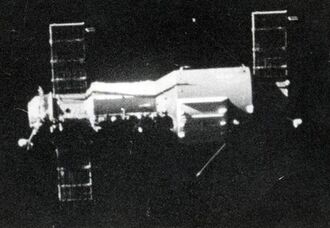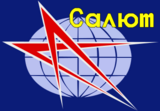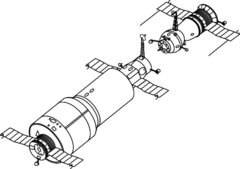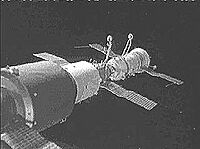Salyut 1 facts for kids

Salyut 1 as seen from the departing Soyuz 11
|
|
 |
|
| Station statistics | |
|---|---|
| COSPAR ID | 1971-032A |
| SATCAT № | 05160 |
| Call sign | Salyut 1 |
| Crew | 3 |
| Launch | April 19, 1971, 01:40:00 UTC |
| Carrier rocket | Proton-K |
| Launch pad | Site 81/24, Baikonur Cosmodrome, Soviet Union |
| Reentry | October 11, 1971 |
| Mission status | De-orbited |
| Mass | 18,425 kg (40,620 lb) |
| Length | ~20 m (66 ft) |
| Diameter | ~4 m (13 ft) |
| Pressurised volume | 99 m3 (3,500 cu ft) |
| Perigee | 200 km (124 mi) |
| Apogee | 222 km (138 mi) |
| Orbital inclination | 51.6 degrees |
| Orbital period | 88.5 minutes |
| Days in orbit | 175 days |
| Days occupied | 24 days |
| No. of orbits | 2,929 |
| Distance travelled | 118,602,524 km (73,696,192 mi) |
| Configuration | |

Soyuz docking with Salyut 1
|
|
Salyut 1 (also known as DOS-1) was the very first space station ever launched. The Soviet Union sent it into space on April 19, 1971. It orbited Earth, allowing astronauts to live and work there for a time.
Salyut 1 was part of the Salyut program, which launched several more successful space stations. The last part of this program, called Zvezda, is now a key section of the International Space Station. It is still in orbit today.
Salyut 1 was built from a design originally meant for military space stations. It had five main parts, including a place for spacecraft to connect and a special observatory for looking at stars.
Two spacecraft, Soyuz 10 and Soyuz 11, visited Salyut 1. Soyuz 10 could not connect properly, so its crew had to return home. The Soyuz 11 crew successfully docked and lived on Salyut 1 for 23 days. Sadly, they died on their way back to Earth due to a technical problem. They are the only people to have died in space. Salyut 1's mission ended on October 11, 1971, when it safely burned up in Earth's atmosphere.
Contents
Why Was Salyut 1 Built?
Salyut 1 started as a change to the Soviet military's Almaz space station plan. After the US landed on the Moon in 1969, the Soviets decided to focus more on orbiting space stations. They hoped to build a space station that would be better than the US Skylab program, which was also being developed.
The basic design of Salyut 1 was used for all Soviet space stations that came after it, including the famous Mir station. Even though Salyut 1 was a civilian station, it still carried some military experiments. These included tools to measure light and study rocket exhaust.
Building and Operating Salyut 1
Work on Salyut 1 began in early 1970. After almost a year, it was sent to the Baikonur Cosmodrome launch site. The final parts were put together there. The whole Salyut program was managed by Kerim Kerimov.
The launch was supposed to be on April 12, 1971. This date was chosen to celebrate 10 years since Yuri Gagarin's first flight into space. But technical issues caused a delay until April 19.
The first crew launched on the Soyuz 10 mission. They had trouble connecting to the station and could not get inside. The mission was stopped, and the crew returned safely to Earth.
A different crew launched on Soyuz 11 and stayed on Salyut 1 for 23 days. This was the first time a space station had been lived in, and it set a new record for time spent in space.
However, this success ended sadly. The crew died during their return to Earth. A valve in their capsule opened too early, causing them to lose air. They were the first and, as of 2024, only humans to have died in space. After this accident, all space missions were paused. The Soyuz spacecraft was redesigned to make it safer.
Salyut 1 was intentionally brought back to Earth after six months. It ran out of fuel before the redesigned Soyuz spacecraft could reach it.
How Salyut 1 Was Built
When Salyut 1 was launched, its main goal was to test space station systems. It also aimed to do scientific research and experiments. The station was about 20 meters (66 feet) long and 4 meters (13 feet) wide. It had an inside space of 99 cubic meters (3,500 cubic feet) and weighed 18,425 kilograms (40,620 pounds).
Salyut 1 had several sections. Three of them were pressurized, meaning they had air for the crew to breathe. Two of these sections could be entered by the astronauts.
Connection Compartment
This part of Salyut 1 had the only docking port. This allowed one Soyuz 7K-OKS spacecraft to connect. It was the first time the Soviet SSVP docking system was used. This system allowed astronauts to move between their spacecraft and the station. This same system is still used today!
Main Living Area
The second and largest part was about 4 meters (13 feet) wide. Videos from inside showed enough room for eight chairs and many control panels. There were also 20 windows, though some were blocked by equipment. Inside, different colors like light gray, green, and yellow were used. This helped the astronauts know which way was up and down in zero gravity.
Other Sections
The third pressurized section held important equipment. This included controls for communication, power, and the life support system. The fourth and last section was not pressurized. It contained the engines and their controls. Salyut also had backup batteries, extra oxygen and water, and systems to recycle air.
Outside the station were two sets of solar cell panels. These looked like wings and collected energy from the sun. There were also radiators for the heat control system and devices to help the station stay in the correct position.
Salyut 1 was built using a modified design from the Almaz military stations. Its service module, which helped it operate, was a changed version of a Soyuz spacecraft part.
Orion 1 Space Observatory
The Orion 1 Space Observatory was a special telescope on Salyut 1. It was designed by Grigor Gurzadyan from Byurakan Observatory in Armenia. This observatory was used to study stars using ultraviolet light.
It had a mirror telescope and a spectrograph. This equipment helped scientists get detailed images of stars like Vega and Beta Centauri. Viktor Patsayev, one of the crew members, operated the telescope. He was the first person to use a telescope outside Earth's atmosphere.
Salyut 1 Facts
- Length: 15.8 meters (51.8 feet)
- Widest point: 4.15 meters (13.6 feet)
- Space for living: 90 cubic meters (3,178 cubic feet)
- Weight at launch: 18,900 kilograms (41,667 pounds)
- Rocket used: Proton
- Solar panel width: about 10 meters (33 feet)
- Solar panel area: 28 square meters (301 square feet)
- Number of solar panels: 4
- Resupply spacecraft: Soyuz (though none were sent after the redesign)
- Docking ports: 1
- Total crewed visits: 2
- Total long crewed missions: 1
Spacecraft That Visited Salyut 1
Only two spacecraft ever tried to connect with Salyut 1: Soyuz 10 and Soyuz 11. Soyuz 10 failed to connect properly. Soyuz 11 successfully docked and its crew worked on Salyut 1 for 23 days. Sadly, the Soyuz 11 astronauts died during their return to Earth.
Soyuz 10 Mission
Soyuz 10 launched on April 22, 1971. It carried three cosmonauts: Vladimir Shatalov, Aleksei Yeliseyev, and Nikolai Rukavishnikov. It took them 24 hours to reach Salyut 1.
On April 24, Soyuz 10 gently connected with Salyut 1. But they could not make a strong connection due to technical problems. The crew could not enter the station. They had to return to Earth safely on April 24.
Soyuz 11 Mission
Soyuz 11 launched on June 6, 1971. It took about three hours for it to connect with Salyut 1 on June 7. The three cosmonauts, Georgy Dobrovolsky, Viktor Patsayev, and Vladislav Volkov, entered Salyut 1.
Their mission had several goals:
- Checking how the space station's systems and equipment worked.
- Testing how to guide and control the station in orbit.
- Studying Earth's surface, weather, and ice from space.
- Looking at physical features and events in space and the atmosphere.
- Doing medical and biological studies to see how space travel affects humans.
On June 29, after 23 days in space, the mission ended early. There were problems on the station, including a small electrical fire. The crew moved back into their Soyuz 11 capsule to return to Earth.
The capsule landed safely in Kazakhstan. But when the recovery team opened the hatch, they found all three crew members had died. An investigation found that a pressure relief valve had failed during reentry. This caused the air inside the capsule to escape. The crew was not wearing pressure suits at the time. After this tragedy, it was decided that all future Soyuz missions would require astronauts to wear pressure suits.
Salyut 1's Return to Earth
In July and August 1971, Salyut 1 was moved to a higher orbit. This was to make sure it would not fall back to Earth too soon. Meanwhile, Soyuz capsules were being redesigned to make them safer. This included allowing astronauts to wear pressure suits during launch, docking, and reentry.
However, the Soyuz redesign took too long. By September, Salyut 1 was running out of fuel. It was decided to end the station's mission. On October 11, the main engines were fired to bring it out of orbit. After 175 days in space, the world's first space station safely burned up over the Pacific Ocean.
Reports later said that most of Salyut 1's studies involved looking at things with optical tools. Other studies used radio waves and other measurements.
See also
- Salyut 6
- Soviet space program



